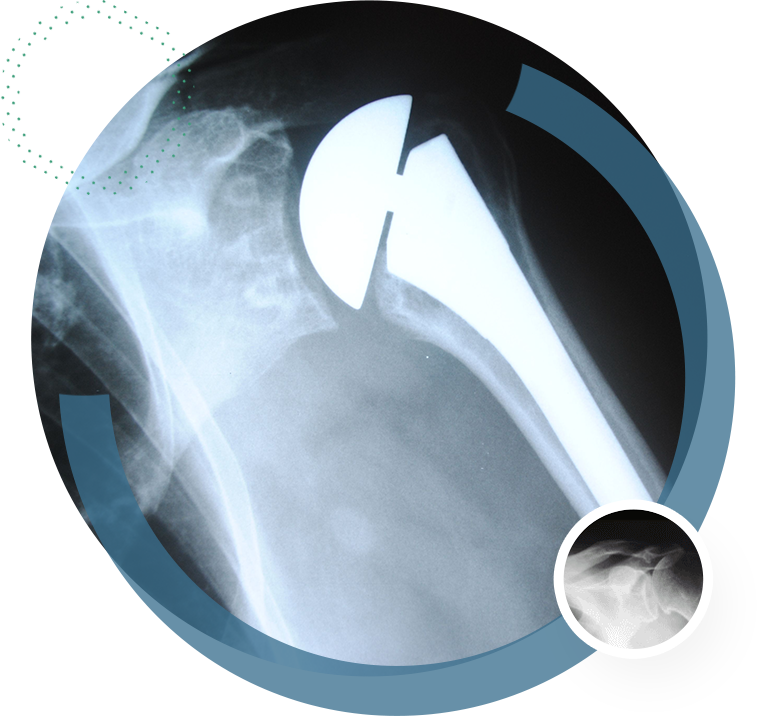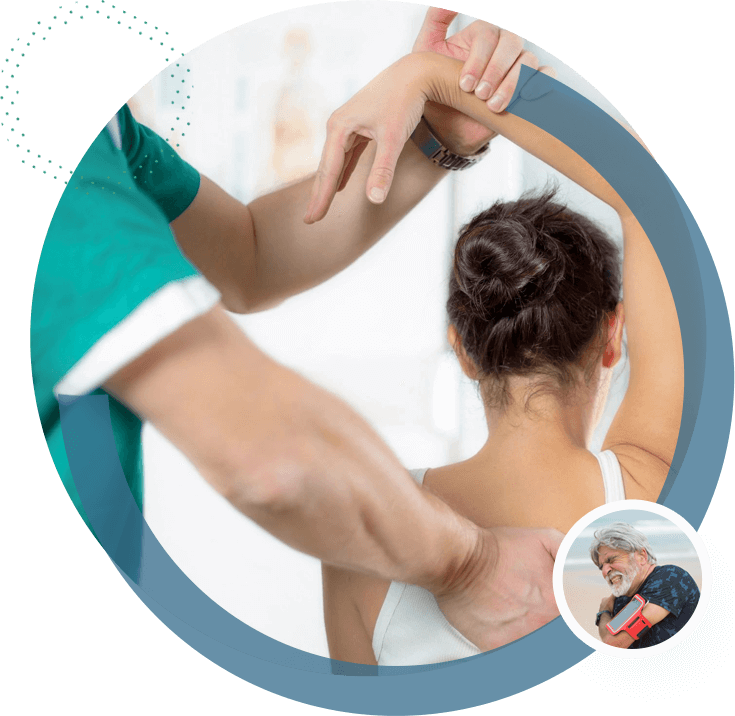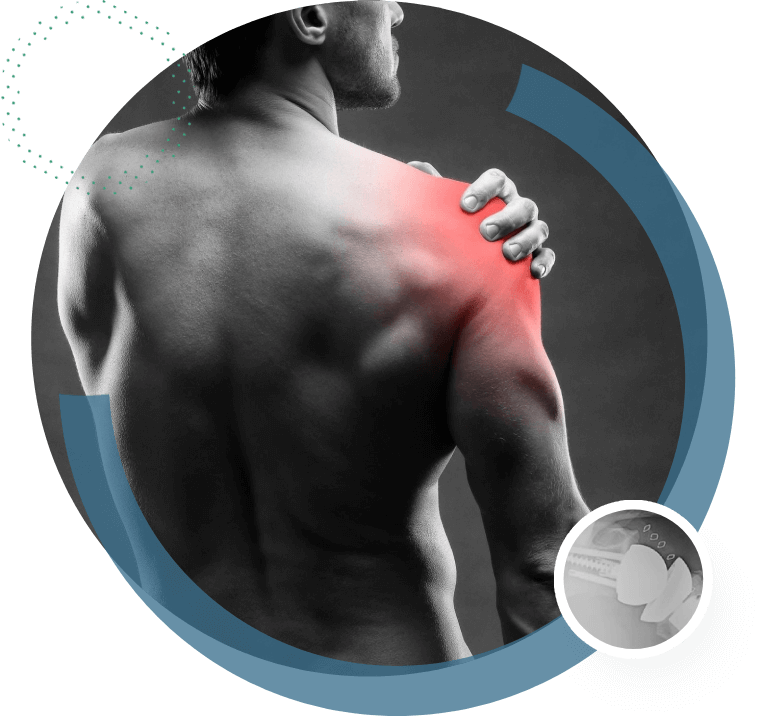
San Diego Shoulder Replacement Surgery
Shoulder replacement surgery is a safe and effective treatment option for patients with severe shoulder arthritis. To learn more, continue reading or schedule an appointment at Dr. DuBois’ La Mesa, CA offices.
SHOULDER REPLACEMENT SURGERY
Patients with severe arthritis may require replacement of the damaged joint to alleviate pain and restore motion. Joint replacement surgery is one of the most commonly performed surgeries in America today and can often return patients to previous levels of activity.
Shoulder replacement surgery involves the removal of the arthritic joint and replacement with a prosthetic implant made of metal and hard plastics that aim to imitate the function of the natural joint. The humeral head is removed and capped with a metal component. The glenoid fossa (shoulder socket) is resurfaced to remove any arthritic bone, with a new socket fitted in place.
Once set in place, the patient's new shoulder joint should allow for a wider range of motion with less pain.
REVERSE SHOULDER REPLACEMENT
For some patients, shoulder arthritis coupled with a severely torn rotator cuff, known as "cuff tear arthropathy," rules out traditional shoulder replacement as an effective treatment option. In these cases, reverse shoulder replacement may be the best option to restore joint functioning and limit pain.
Reverse total shoulder replacement is similar to traditional shoulder replacement; however, the placement of the ball-and-socket components is reversed. The humeral head is removed and replaced with a socket component, while a metal ball is fixed to the glenoid fossa.
Reverse shoulder replacement relies on different muscles to move the arm, so it tends to be a better option for patients who have severe tears in the rotator cuff. Because traditional shoulder replacement components rely on the rotator cuff muscles, these patients will typically experience pain whenever trying to use these muscles.
Learn more about Dr. DuBois and his shoulder pain treatment expertise.
Shoulder Anatomy
The basic shoulder joint comprises two bones: the humerus, or upper arm bone, and the scapula, or shoulder blade. The round head of the humerus fits into a socket on the scapula called the glenoid fossa. These bones form the glenohumeral joint, which is naturally unstable due to the fit of the bones. To describe the fit of the ball within the socket, the glenohumeral joint is often compared to a golf ball sitting on a golf tee.
To provide greater support to the unstable joint, a ring of cartilage called the labrum lines the outer ring of the socket and provides additional depth. The surfaces of the two connecting bones are also covered with cartilage that helps the bones glide against one another during movement. This cartilage prevents friction and makes motion painless.
The rotator cuff is a crucial group of muscles and tendons in the shoulder joint, responsible for stabilizing and facilitating movement. Comprised of four key muscles, it enables a wide range of shoulder motions, such as lifting, reaching, and rotating the arm. However, rotator cuff injuries are common and can result in pain, weakness, and limited range of motion. Early diagnosis and appropriate treatment, including physical therapy or surgery if necessary, are important for recovery. Preventive measures such as maintaining good posture, practicing proper lifting techniques, and engaging in regular shoulder exercises can help reduce the risk of rotator cuff injuries and promote overall shoulder health.

Shoulder Arthritis
Osteoarthritis is a "wear-and-tear" condition that usually affects older patients with previous shoulder joint injuries. Many patients may develop osteoarthritis due to routine motions that gradually wear down the shoulder's components. Patients with occupations that involve overhead activities, such as painters or carpenters, are more at risk of injuring their shoulders due to everyday labor.
Osteoarthritis of the shoulder can cause the following symptoms:
These symptoms can make simple tasks difficult, such as buttoning a shirt or grabbing an item from an overhead shelf. Patients may find everyday tasks or job functions more challenging than usual, reducing health-related quality of life.
Treating Shoulder Arthritis
Many patients manage arthritic symptoms through conservative treatments, which aim to alleviate the role of the damaged anatomy and strengthen the surrounding muscles. Additionally, many treatment options aim to reduce inflammation and encourage regeneration.
Conservative treatment options include:

Shoulder Replacement Surgery
Patients with severe arthritis may require replacement of the damaged joint to alleviate pain and restore motion. Joint replacement therapy is one of America's most commonly performed surgeries and can often return patients to previous activity levels.
Shoulder replacement surgery involves the removal of the arthritic joint and replacement with a prosthetic implant made of metal and hard plastics that aim to imitate the function of the natural joint. The humeral head is removed and capped with a metal component. The glenoid fossa (shoulder socket) is resurfaced to remove any arthritic bone, with a new socket fitted.
Once set in place, the patient's new shoulder joint should allow for a wider range of motion with less pain.
Reverse Shoulder Replacement
For some patients, shoulder arthritis coupled with a severely torn rotator cuff, known as “cuff tear arthropathy,” rules out traditional shoulder replacement as an effective treatment option. The shoulder replacement procedure outlined above, in which the ball and socket components are replaced with new prosthetic components, may result in pain and limited mobility after surgery for these patients. In these cases, reverse shoulder replacement may be the best option to restore joint functioning and limit pain.
Reverse total shoulder replacement is similar to traditional shoulder replacement; however, the placement of the ball-and-socket components is reversed. The humeral head is removed and replaced with a socket component, while a metal ball is fixed to the glenoid fossa.
Reverse shoulder replacement relies on different muscles to move the arm, so it tends to be a better option for patients with severe tears in the rotator cuff. Because traditional shoulder replacement components rely on the rotator cuff muscles, so these patients will typically experience pain when using these muscles.
Total Shoulder Replacement in San Diego, CA
Dr. Benjamin DuBois is an expert shoulder surgeon in San Diego, serving patients in the nearby communities of La Jolla, Carlsbad, La Mesa, Point Loma, Alpine, Del Mar, Rancho Bernardo, Poway, Chula Vista, Coronado, and El Cajon. With advanced fellowship training in shoulder surgery, Dr. DuBois is the area's leading shoulder surgeon and takes a keen interest in shoulder replacement surgery and rotator cuff disorders as well as ultrasound guided injections of platelet rich plasma (PRP).
For more information about treating shoulder arthritis, schedule a time to speak with Dr. DuBois at his offices in La Mesa, CA, at the Grossmont Orthopaedic Medical Group.